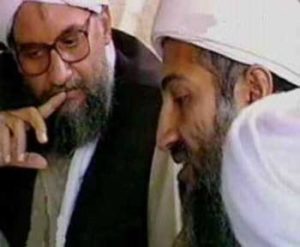I’ve been collecting news stories on the terror suspects arrested in Saudi Arabia. Much of the reporting relies on Saudi security personnel and the Interior Ministry’s statement last week, so it should be read with due skepticism.
There’s a lot to discuss, but I’ll save my comments for later. For the moment it’s worth noting that, as of today, the Saudis are now injecting a new piece of information into the story: the network was taking orders and receiving money from someone in Iran:
- The funding for the AQ cells in Saudi came from one of the major countries in the region in the form of Euros. (al-Qabas, “Oil Cell”)
- Instructions for the cells came from the same major country in the region in which leaders of AQ sought refuge, like the Egyptian Sayf al-Adl who is currently living there. (al-Qabas, “Oil Cell”)
Below is my summary of all the data points I’ve been able to find (sources at the bottom):
The Network
- Five networks have been captured. (al-Qabas, “Oil Cell”)
- Of the 701 people arrested (181 of whom have been released), more than 50% are Saudi citizens. (Dhaydi, “Features”)
- In the new batch of arrests, the demographic has shifted to Mauritania, Pakistan, Afghanistan, and Indonesia. In the past, non-Saudi militants active in the Kingdom came from mainly from Yemen, then Chad, Morocco, and Kuwait. (Dhaydi, “Features”)
- 7 Mauritanians were among those in the “oil cell.” They were pursuing advanced degrees. One had a Master’s degree. The youngest was 35 and all of them played leadership roles. (al-Qabas, “Oil Cell”)
- The seven Mauritanians had a “special driver” visa that enabled them to move around the country freely. (al-Qabas, “Oil Cell”)
- The Afghans arrested were from Waziristan. (Malifi, “Africans”)
- There were Yemenis and Iraqis in the “oil cell”. The number of Yemenis was higher than those of other nationalities in the cell. The number of Saudis in the cell is equivalent to that of the other nationalities in the cell. (al-Qabas, “Oil Cell”)
- Only 50% of those in cell were Saudis. The rest came during pilgrimage season and did not go home. (Adnkronos, “Terror Cell”)
- Most of the foreigners in the cell were recruited by imams in their home countries, or through the Internet. (Adnkronos, “Terror Cell”)
Recruitment
- Because of Saudi security measures, the militants altered their methods of recruitment and their procurement of equipment. (Dhaydi, “Features”)
- In Saudi Arabia, the main tool of recruitment is the Internet. (Dhaydi, “Features”)
- The Eastern Province cell recruited illegal African residents to find jobs in the oil sector. (Malifi, “Africans”)
- The recruiter network carried out organized efforts to target youth and to send them for training outside Saudi Arabia. (al-Sharq al-Awsat, “520 Arrested”; Malifi, “Africans”)
Leadership
- There is no single leader for al-Qaeda in Saudi Arabia. (Dhaydi, “Features”)
- A mobile phone that belonged to a member of the Eastern Province cell had a voice message from Zawahiri on it. This is the second recent message from Zawahiri that has been found recently on a terror suspect’s phone in Saudi. (Malifi, “Africans”)
- The leader of one cell had a message from Zawahiri instructing him to gather money and promising to send people from Iraq, Afghanistan, and North Africa to target the oil infrastructure and fight security forces. (al-Sharq al-Awsat, “520 Arrested”)
- 7 Mauritanians were among those in the “oil cell.” They were in graduate school. One had a Master’s degree. The youngest was 35 and all of them played leadership roles. (al-Qabas, “Oil Cell”)
- Instructions for the cells came from the same major country in the region in which leaders of AQ sought refuge, like the Egyptian Sayf al-Adl who is currently living there. (al-Qabas, “Oil Cell”)
Funding
- The new batch of militants are well funded. (Dhaydi, “Features”)
- The Yanbu cell forged coupons for sacrificial livestock and sold them at pilgrimage [presumably to raise capital]. (al-Sharq al-Awsat,” 520 Arrested”; Malifi, “Africans”)
- Cells planned to raise funds and send them outside the Kingdom. (al-Sharq al-Awsat, “520 Arrested”)
- The leader of one cell had a message from Zawahiri instructing him to gather money and promising to send people from Iraq, Afghanistan, and North Africa to target the oil infrastructure and fight security forces. (al-Sharq al-Awsat, “520 Arrested”)
- The funding for the AQ cells in Saudi came from one of the major countries in the region in the form of Euros. (al-Qabas, “Oil Cell”)
- The financing of AQ in Saudi came from one particular direction, especially when AQ was being rebuilt. (al-Qabas, “Oil Cell”)
Preparation
- The weapons and money caches were professionally sealed for long-term storage. (Dhaydi, “Features”)
- Much of the money, weapons, and equipment were buried in remote desert areas. (al-Qabas, “Oil Cell”)
Media
- The media cell was responsible for defaming clerics, raising doubts, and excommunicating other Muslims, all online. (al-Sharq al-Awsat, “520 Arrested”; Malifi, “Africans”)
Targets and Tactics
- The cells are following the strategy outlined by Abu Bakr Naji in his Management of Savagery.
- One of the five cells, the “oil cell,” planned to penetrate the secret police adminstrative building in Khafji with car bombs and to blow up oil installations in the Eastern region. (al-Qabas, “Oil Cell”)
- Cell members intended to attack oil installations in Gulf states. They were going to use boats to attack some installations. (al-Qabas, “Oil Installations”)
- Cell members had maps and pictures of hotels in many Gulf countries that foreigners stay in. (al-Qabas, “Oil Installations”)
- Cell members plotted to attack boats in the Gulf. (al-Qabas, “Oil Installations”)
- The plan of attack was to hit a variety of places while making sure that the cell’s base of operations was far away from the targets. (al-Qabas, “Oil Installations”)
Sources
Mashari al-Dhaydi, “Features of the New al-Qaeda,” al-Sharq al-Awsat, 26 June 2008.
Muhammad al-Malfi, “A High-Level Security Source: The Africans Are Actually from Mauritania and the Asians Are Afghans from Waziristan,” al-Watan, 26 June 2008.
“520 Arrested, Planned to Attack Oil and Security Installations and Spread the Takfir Methodology on the Internet,” al-Sharq al-Awsat, 26 June 2008.
“Saudi: Oil Cell Planned to Storm the Building of Secret Police of al-Khafji with Car Bombs,” al-Qabas, 29 June 2008.
“Oil Installations in Gulf Countries Intended Targets,” al-Qabas 27 June 2008.
“Saudi Arabia: Terror Cell Received Orders from al-Qaeda Deputy,” Adnkronos.com, 26 June 2008.





2 Responses
While I applaud your diligence, I don’t know if I would get too wrapped up in this. Chances are this is, in large part, pure BS. The fact that they had to release 121 of these guys for lack of evidence is a telling clue. Apparently they were running around arresting people BEFORE they had any evidence on them.
To put this into further context, and for a good laugh, go to:
http://www.asecondlookatthesaudis.com
And check out “Part 4”, the bottom half of page 56.
It’s really getting pathetic how the western press continues to fall for this garbage every time. And note the explicit reference to attacks on oil facilities. Now what do you think that will do to the price of oil?
Finally, note the fact that the Saudis have already been caught red handed trying to frame Iran (and the Maliki government in Iraq) with forged evidence, as reported by the New York Times:
http://www.nytimes.com/2007/07/27/world/middleeast/27saudi.html?_r=1&ref=world&oref=slogin
As I say, these guys completely lack credibility, to say the least.
Not to be too glib about this, but aren’t the Saudis the Jihadis to begin with. . . .